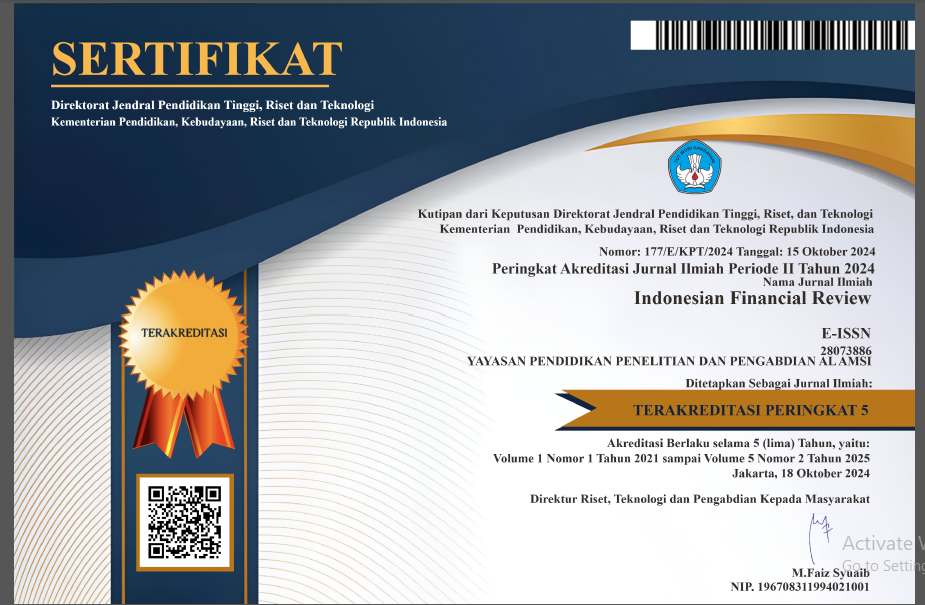Does Downside Risk Matter more in Asset Pricing? Evidence from Indonesia
DOI:
https://doi.org/10.55538/ifr.v2i2.21Keywords:
downside risk, semi-deviation, downside beta, beta, standard deviationAbstract
This study examines downside risk matters in asset pricing, particularly evidence from Indonesia. Using ten reference indexes for passive instruments and 674 companies listed on the Indonesia Stock Exchange between 2020-2021. The four measurements are the traditional families (beta and standard deviation/risk) and downside risk families (semi-deviation and downside beta). For those, we divide 674 stocks into quintiles (5 groups). Every quintile is investigated by four measurements using Fama-Macbeth regression. semi-deviation in those close to standard deviation. Standard deviation affects semi-deviation portfolios in quintiles 1 and 2 and portfolios sorted beta and downside beta in quintile 2. Beta does not affect all portfolios. Eighth, semi-deviation affects portfolios sorted semi-deviation in quintiles 1,2,3,and 5. Downside beta does not affect all portfolios.
References
Amaya, D., Christoffersen, P., Jacobs, K., & Vasquez, A. (2015). Does realized skewness predict the cross-section of equity returns? Journal of Financial Economics, 118(1), 135–167. https://doi.org/https://doi.org/10.1016/j.jfineco.2015.02.009
Ang, A., Chen, J., & Xing, Y. (2006). Downside risk. The Review of Financial Studies, 19(4), 1191–1239.
Baghdadabad, M. R. T., & Fooladi, M. (2015). Using downside risk in evaluating the performance of Malaysian mutual funds. International Journal of Emerging Markets.
Barry, C. B., Goldreyer, E., Lockwood, L., & Rodriguez, M. (2002). Robustness of size and value effects in emerging equity markets, 1985–2000. Emerging Markets Review, 3(1), 1–30. https://doi.org/https://doi.org/10.1016/S1566-0141(01)00028-0
Bawa, V. S., & Lindenberg, E. B. (1977). Capital market equilibrium in a mean-lower partial moment framework. Journal of Financial Economics, 5(2), 189–200. https://doi.org/https://doi.org/10.1016/0304-405X(77)90017-4
Boyer, B., Mitton, T., & Vorkink, K. (2010). Expected idiosyncratic skewness. The Review of Financial Studies, 23(1), 169–202.
Diacogiannis, G. P. (1994). Three?parameter asset pricing. Managerial and Decision Economics, 15(2), 149–158.
Drew, M. E., Naughton, T., & Veeraraghavan, M. (2003). Firm size, book-to-market equity and security returns: Evidence from the Shanghai Stock Exchange. Australian Journal of Management, 28(2), 119.
Estrada, J. (2002). Systematic risk in emerging markets: the D-CAPM. Emerging Markets Review, 3(4), 365–379. https://doi.org/https://doi.org/10.1016/S1566-0141(02)00042-0
Estrada, J. (2007). Mean-semivariance behavior: Downside risk and capital asset pricing. International Review of Economics & Finance, 16(2), 169–185. https://doi.org/https://doi.org/10.1016/j.iref.2005.03.003
Estrada, J., & Serra, A. P. (2005). Risk and return in emerging markets: family matters. Journal of Multinational Financial Management, 15(3), 257–272.
Fama, E. F., & MacBeth, J. D. (1973). Risk, return, and equilibrium: Empirical tests. Journal of Political Economy, 81(3), 607–636.
Fernandez-Perez, A., Frijns, B., Fuertes, A. M., & Miffre, J. (2018). The skewness of commodity futures returns. Journal of Banking and Finance, 86. https://doi.org/10.1016/j.jbankfin.2017.06.015
Friend, I., & Westerfield, R. (1980). Co-skewness and capital asset pricing. The Journal of Finance, 35(4), 897–913.
Gul, F. (1991). A theory of disappointment aversion. Econometrica: Journal of the Econometric Society, 667–686.
Harlow, W. Van, & Rao, R. K. S. (1989). Asset pricing in a generalized mean-lower partial moment framework: Theory and evidence. Journal of Financial and Quantitative Analysis, 24(3), 285–311.
Harvey, C. R. (1995). Predictable risk and returns in emerging markets. The Review of Financial Studies, 8(3), 773–816.
Harvey, C. R., & Siddique, A. (2000). Conditional skewness in asset pricing tests. The Journal of Finance, 55(3), 1263–1295.
Hogan, W. W., & Warren, J. M. (1974). Toward the development of an equilibrium capital-market model based on semivariance. Journal of Financial and Quantitative Analysis, 9(1), 1–11.
Hwang, S., & Satchell, S. E. (1999). Modelling emerging market risk premia using higher moments. International Journal of Finance & Economics, 4(4), 271–296.
Kraus, A., & Litzenberger, R. H. (1976). Skewness preference and the valuation of risk assets. The Journal of Finance, 31(4), 1085–1100.
Lintner, J. (1965). Security prices, risk, and maximal gains from diversification. The Journal of Finance, 20(4), 587–615.
Mamoghli, C., & Daboussi, S. (2010). Capital asset pricing models and performance measures in the downside risk framework. Journal of Emerging Market Finance, 9(2), 95–130.
Markowitz, H. (1952). Portfolio selection. Journal of Finance, 7(1), 77–91.
Mossin, J. (1966). Equilibrium in a capital asset market. Econometrica: Journal of the Econometric Society, 768–783.
Neuberger, A. (2012). Realized skewness. The Review of Financial Studies, 25(11), 3423–3455.
Pedersen, C. S., & Hwang, S. (2007). Does downside beta matter in asset pricing? Applied Financial Economics, 17(12), 961–978.
Poitras, G., & Heaney, J. (1999). Skewness preference, mean–variance and the demand for put options. Managerial and Decision Economics, 20(6), 327–342.
Rashid, A., & Hamid, F. (2015). Downside risk analysis of returns on the Karachi Stock Exchange. Managerial Finance, 41(9), 940–957. https://doi.org/10.1108/MF-09-2014-0245
Roy, A. D. (1952). Safety First and the Holding of Assets. Econometrica, 20(3), 431–449. https://doi.org/10.2307/1907413
Serra, A. P. (2003). The cross-sectional determinants of returns: Evidence from Emerging Markets’ Stocks. Journal of Emerging Market Finance, 2(2), 123–162.
Sharpe, W. F. (1964). Capital asset prices: A theory of market equilibrium under conditions of risk. The Journal of Finance, 19(3), 425–442.
Snedecor, G. W., & Cochran, W. G. (1967). Statistical methods 6th edition Oxford and IBH Publishing Co. New Delhi.
Syahputra, I. B. (2018). PORTOFOLIO OPTIMAL SAHAM METODE DOWNSIDE RISK PADA BURSA EFEK INDONESIA TAHUN 2015-2017. Universitas Gadjah Mada.
Tversky, A., & Kahneman, D. (1992). Advances in prospect theory: Cumulative representation of uncertainty. Journal of Risk and Uncertainty, 5(4), 297–323.
Wang, Y., & Di Iorio, A. (2007). The cross-sectional relationship between stock returns and domestic and global factors in the Chinese A-share market. Review of Quantitative Finance and Accounting, 29(2), 181–203.
Published
Versions
- 2023-03-02 (2)
- 2023-03-02 (1)
How to Cite
Issue
Section
License
Copyright (c) 2023 Iman Lubis, Nailin Nikmatul Maulidiyah

This work is licensed under a Creative Commons Attribution 4.0 International License.
















